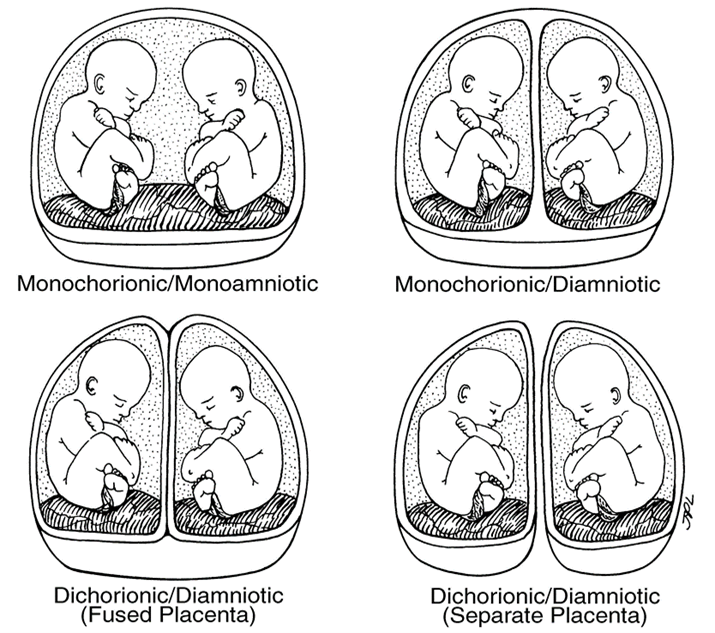Multiple pregnancy
Congratulations!
Discovering you are expecting twins or higher order pregnancies such as triplets can be quite a surprise be it delight or shock.
This leaflet provides information on multiple pregnancy, it focuses mainly on twins but is relevant to any pregnancy when more than one baby is expected.
Most multiple pregnancies are normal and healthy and therefore most of the advice given to women expecting one baby is also relevant. However, there is an increased risk of complications for you and your babies which mean you need to be monitored closely during your pregnancy.
Diagram of Types of Twins

Types of twins
There are different types of twins. This information is important for the management of your pregnancy. It is important to find out the chorionicity of your pregnancy, which means whether or not your babies share a placenta (the afterbirth). Finding this out early is important because babies who share a placenta have a higher risk of health problems. The type of twin pregnancy will usually be determined at your dating scan between 11-14 weeks of pregnancy.
1. Dichorionic Diamniotic (DCDA) Non – Identical
Non identical twins are created when a woman produces 2 eggs at the same time, and both are fertilised by a different sperm.
Each baby has a separate placenta (afterbirth) and separate amniotic fluid sacs.
Most babies who do not share a placenta are non-identical.
However, it is possible for babies not sharing a placenta to be identical as well.
This is because nearly a third of MCDA (identical) twins will each have their own placenta and hence have the same appearance as DCDA (non –identical) twins.
2. Monochorionic Diamniotic (MCDA) Identical
A single egg is fertilised then splits into 2 (rarely 3) creating identical, same genes, features and sex.
Each baby shares the same placenta but normally have their own sac of amniotic fluid.
Monochorionic Monoamniotic (MCMA) Identical
These twins are rare, resulting from one fertilised egg which has split into 2 but later in development.
These twins are identical and share a placenta and also share a sac of amniotic fluid.
Higher order pregnancies (Triplets or more)
These come from 1 or more fertilised eggs developing into 3 or more babies in your womb. They can be identical or a mixture of non-identical and identical.
For triplet pregnancies there are more possible combinations
Trichorionic - each baby has a separate placenta
- Dichorionic - two of the babies share a placenta and the third baby is separate
- Monochorionic – all three babies share a placenta
- It is possible for triplets to share an amniotic sac as well as a placenta.
All ladies expecting triplets will be under the care of the Fetal Medicine Clinic and will be scanned fortnightly from 16 weeks pregnant.
Antenatal Care
While you are pregnant you will be offered a series of antenatal appointments with your Obstetrician and your midwife to check on your health and the health of your babies.
Your appointments at the hospital and with the community midwife will give you an opportunity to discuss nutrition, antenatal, mental health and well-being, signs and symptoms of pre-term labour, the likely mode and timing of delivery and breastfeeding.
You will have your blood pressure and urine checked at each appointment. You will be offered blood tests in pregnancy to identify any signs of anaemia and if you need to be taking iron tablets.
Scans
Scans are used to check the babies growth, health and position.
Expecting twins or triplets means you will be offered more scans as you are more likely to have the babies early and to experience common pregnancy related health problems.
An anomaly scan will be performed at around 20 weeks pregnant to check babies’ growth and development and to exclude abnormalities.
DCDA Twins (Non-Identical)
You will have scans every 4 weeks after your anomaly scan. These are usually at about 24, 28, 32 and 36 weeks of pregnancy.
MCDA/MCMA Twins (Identical) and Triplets
You will be referred to the Fetal Medicine Clinic for closer surveillance.
You will have fortnightly scans and an appointment with the Consultant from around 16 weeks pregnant to watch for signs of Twin to Twin Transfusion Syndrome and slow growth.
Twin to Twin Transfusion Syndrome (TTTS)
This is a rare complication. TTTS develops in about 10-15% of these pregnancies. It only occurs in babies sharing a placenta. It happens when a connection between the two babies’ blood vessels in the placenta causes one baby to get too much blood flow and the other too little. This problem can occur at any stage but more commonly occurs between 16 and 26 weeks of pregnancy. It is diagnosed by scan usually by detecting too much fluid around one twin and reduced fluid around the other twin. It is not caused by anything you have done.
TTTS can cause serious complications and if suspected then the Consultant will continue to monitor your pregnancy carefully with frequent scans. You will be referred to the Bristol Fetal Medicine Unit at St Michaels Hospital for further review and possible treatment.
Signs of TTTS could be a sudden increase in size, feeling short of breath, tightening across your abdomen and your abdomen becoming very tense and painful, all this can occur because there is greatly increased amniotic fluid in one sac.
Please contact your Community Midwife or local Hospital if any concerns.
What problems are associated with multiple pregnancy?
- Growth restriction (either one or more of the babies is small)
- Minor problems such as sickness, heartburn, ankle swelling, and other symptoms of pregnancy may be worse
- Anaemia – due to the extra demand for iron and vitamins
- Gestational diabetes (pregnancy associated diabetes)
- Developing high blood pressure or pre-eclampsia
- Premature labour – multiples are more likely to deliver before 37 weeks pregnant.
Planning your birth
Decisions related to timing and the way in which you will deliver are best discussed with your obstetrician.
Every multiple birth is unique and will depend on a number of factors such as you and your babies wellbeing, the number of placentas, the position of the babies in the womb, any previous pregnancies you have had and your hopes and expectations.
You may go in to labour naturally or offered Induction of labour.
In some cases, a caesarean section is recommended but in the majority of cases a vaginal birth is possible.
Triplets and more are almost always delivered by Caesarean Section.
Useful Websites
For more detailed information and leaflets please visit –
Twins Trust (formerly TAMBA)
Website: https://twinstrust.org/
Tel no: 01252 332344
Multiple Births Foundation
Website: http://www.multiplebirths.org.uk/
Tel no: 020 8383 3519




